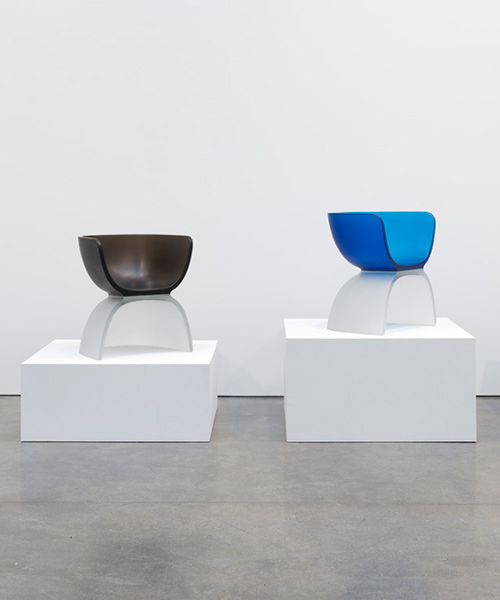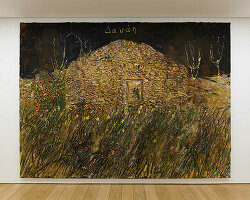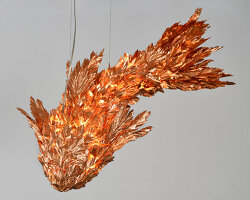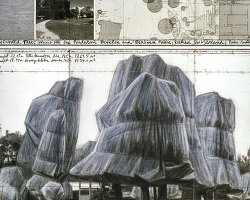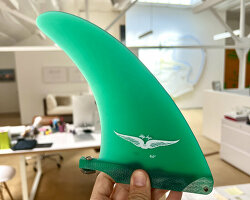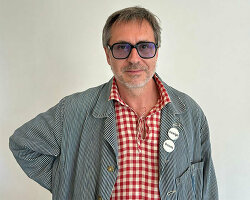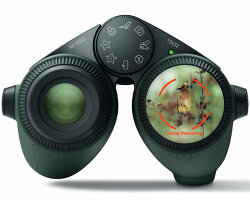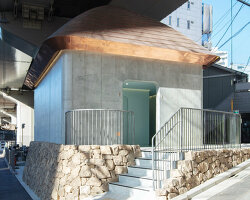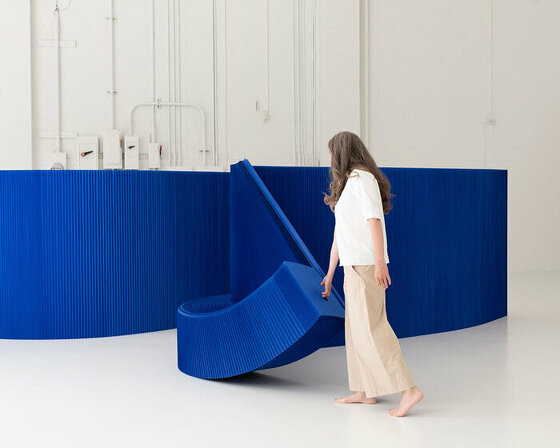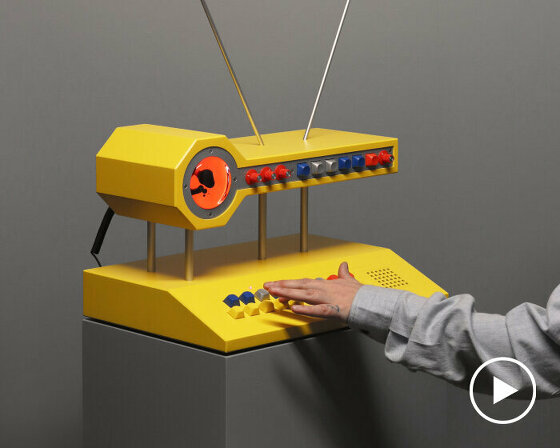from now until february 20, 2019, gagosian presents marc newson’s first exhibition of limited-edition furniture pieces in more than a decade. although newson has recently collaborated with knoll, louis vuitton, and NIKE, this exhibition revisits the designer’s roots as a jeweler and silversmith, with each piece an exploration of increasingly complex, decorative techniques made on unprecedented scales.
cast glass chairs, expertly manufactured in the czech republic, are continuous symmetrical forms comprised of two hollow quarter-spheres, with boldly-colored upper halves that rest on clear bases. for another collection of furniture pieces, newson employed chinese cloisonné, an ancient enameling technique that dates back to the 13th or 14th century. their exterior ornamentation reveals a wide-range of aesthetic influences: from newson’s signature ‘orgone’ pattern, to traditional chinese motifs, such as magnolias and cherry blossom branches.
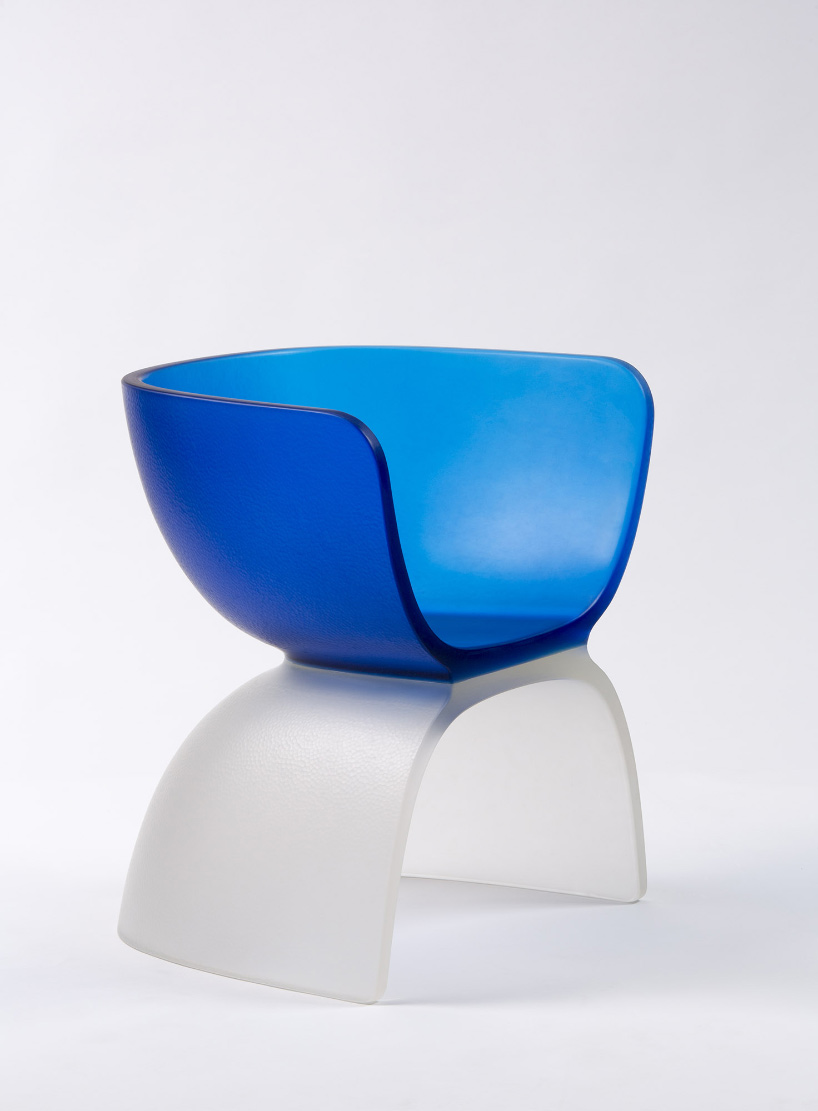
marc newson | chair, 2017
cast glass | 29 1/8 x 27 1/4 x 21 5/8 in (74 x 69.1 x 54.9 cm)
© marc newson | photo by jaroslav kvíz, courtesy gagosian
also included at the gagosian exhibition are newson’s ‘murrina’ desks, tables, and consoles, with sloping and beveled planes unified beneath fields of cell-like spots set on vivid colored grounds. the effect is rendered by fusing glass rods together and then slicing them to reveal patterned cross-sections. finally, the exhibit includes a new series of aluminum surfboards, as well as an aikuchi sword made by a japanese ‘living national treasure’ from the renowned tōhoku region. the exhibition is on view at gagosian’s west 21st street gallery until february 20, 2019.
at the opening of the exhibition, designboom spoke with marc newson about his fascination with craftsmanship, the techniques he used for the presented works, and his favorite piece in the exhibition.
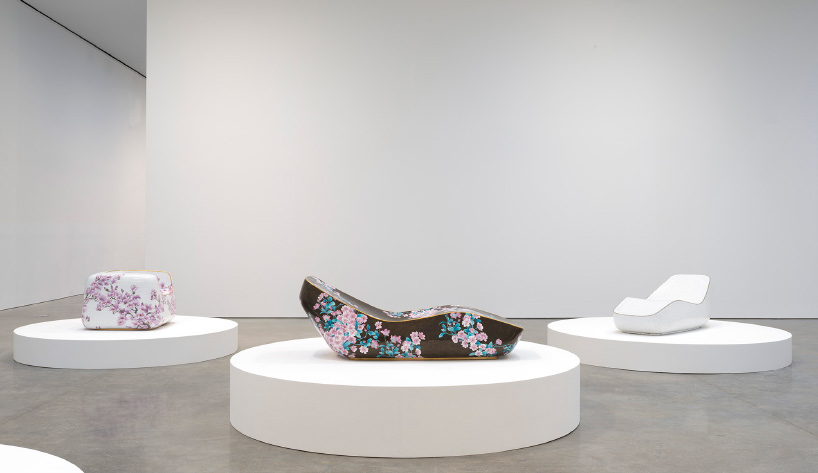
marc newson | installation view, 2018
artwork © marc newson | photo by rob mckeever, courtesy gagosian
designboom (DB): can you talk about your interest in the cloisonné process?
marc newson (MN): I trained as a jeweler and silversmith, so it’s a process that I’ve been aware of since I was a teenager. it has always fascinated me, because it’s so massively labor intensive. someone has to put all those little things on, all those little bits and pieces. I’m just sort of obsessed with this kind of mad process, and became more obsessed with finding people that can do it. although the name of the process is french, this work is really done in china, and it’s always been done in china. you can really only get it done in beijing, but there’s still not that many people there that can do it.
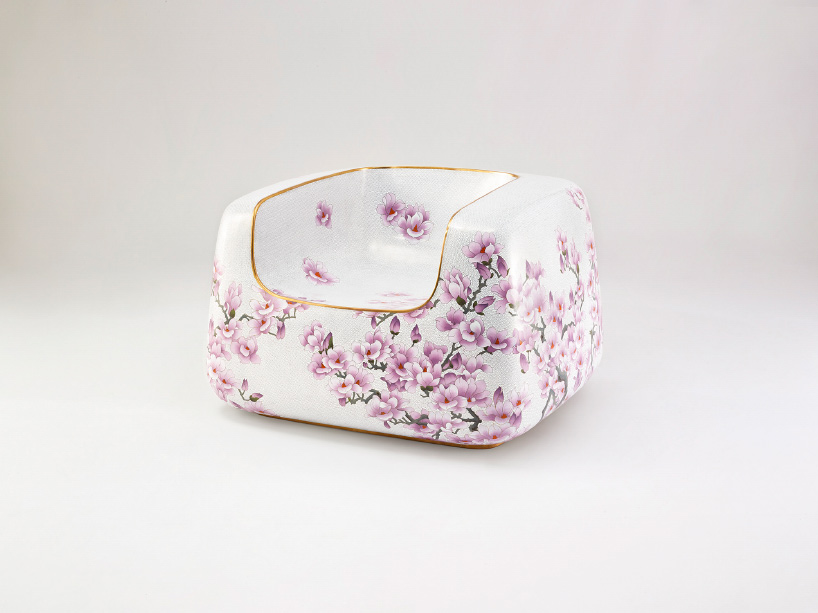
marc newson | cloisonné white magnolia chair, 2017
cloisonné enamel, copper | 26 1/16 x 40 3/16 x 37 1/4 in (66.5 x 102 x 94.5 cm)
© marc newson | photo by xiangzhe kong, courtesy gagosian
MN (continued): we had to rebuild a factory, and build an oven that was big enough to hold these pieces, because normally they produce only little things. so, we built a pit specifically for these works. we had to put together a team of people that could do it — it was mad, it was crazy! it took about five years. there’s like an army of people working in beijing — mostly women actually, interestingly. they had never done anything on that scale. they do little things, teeny things, so it was a bit bonkers.
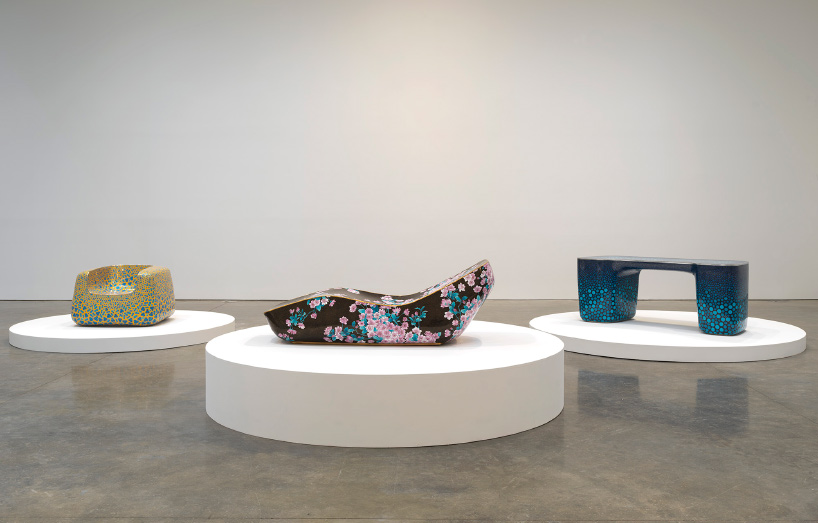
marc newson | installation view, 2018
artwork © marc newson | photo by rob mckeever, courtesy gagosian
DB: we recently spoke with naoto fukasawa about his exhibition of ‘mingei’ objects from japan, and he expressed the idea of not being able to easily perceive how the ancient objects were made. is this a sentiment you can relate to, particularly with the cloisonné pieces?
MN: this is so intensely craft based, and I know intimately how this had to be done. having said that, it’s still kind of alchemy, because every one of the different colors of enamel fires at a different temperatures. the temperature may vary by about 200 degrees, between the black and the red, so it has to be fired about 10 times. the process is basically that they paint the enamel in, and the enamel is sort of a powder, glass powder, and then it melts and fills up all the little holes. what you don’t see is the failure. for every one of these, there’s three that we trashed — the same for the glass chairs.
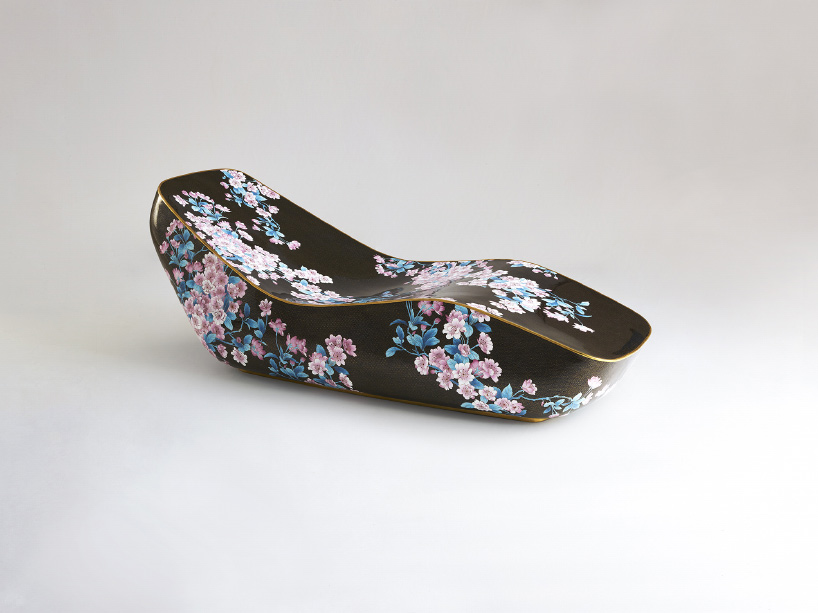
marc newson| cloisonné black blossom lounge, 2017
cloisonne enamel, copper | 30 x 69 11/16 x 30 11/16 in (76 x 177 x 78 cm)
© marc newson | photo by xiangzhe kong, courtesy gagosian
MN (continued): each glass chair takes about six months to build. this is maybe one of the single largest pieces of cast glass in existence. you make the mold out of plaster of paris, and fill it with glass, all crushed up, like gravel — which isn’t that color by the way, it all changes. then, over a period of about three months, the temperature of the oven builds up and up and up, and all the glass melts, and fills all the cavities in the mold. then you have to wait three more months for the oven to cool back down. it’s a fraction of a degree every day.
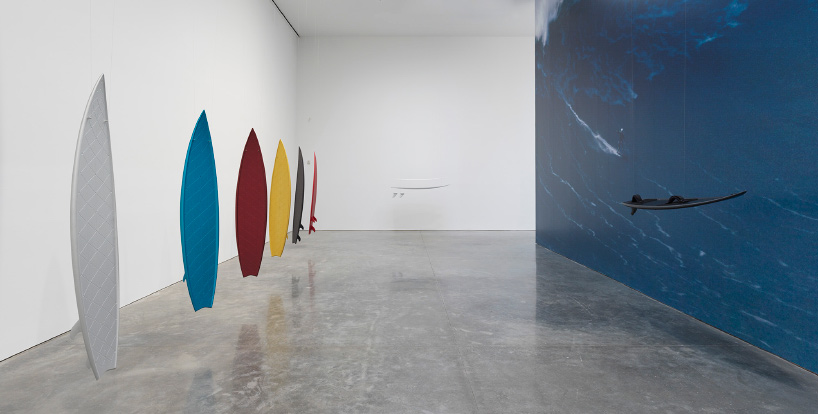
marc newson | installation view, 2018
artwork © marc newson | photo by rob mckeever, courtesy gagosian
DB: can you be sure of the final color?
MN: honestly, at that point you really don’t care about the color, you’re just praying that the thing hasn’t cracked. for every one that comes out, one gets trashed, and you won’t know for six months. only one can go in the oven at a time — it’s mental. it’s made in the czech republic in what was historically known as bohemia. the czech republic has this deep history with the production of glass. it is literally the only place on earth you can do it. people always ask: what do you do about people trying to copy things? I say, good luck!
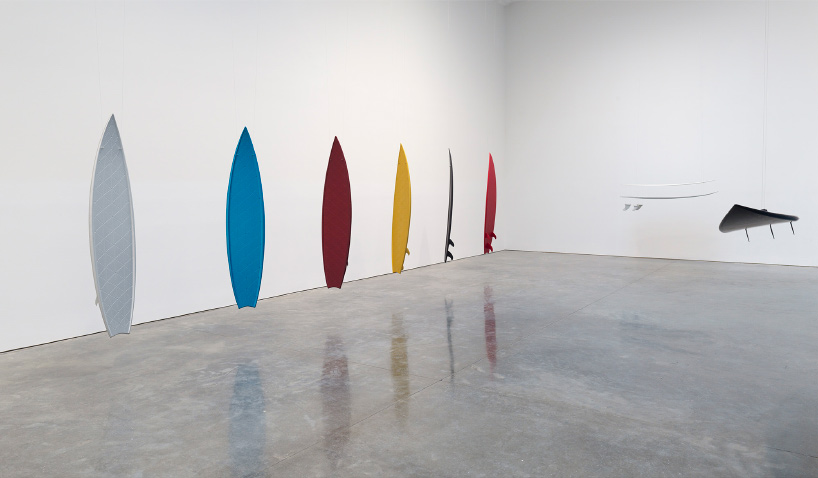
marc newson | installation view, 2018
artwork © marc newson | photo by rob mckeever, courtesy gagosian
DB: do you have a favorite story, or experience attached to a particular piece or series?
MN: the tsunami in japan really devastated a particular region called tōhokualt. that was where a lot of the craftspeople were based. a lot of craftspeople’s industries were wiped out — not only wiped out but killed, and in particular craftspeople that were producing things like japanese swords. I was invited by the japanese government to work with an 11th generation master sword maker. he’s what they refer to as a ‘living national treasure’ — they are people in japan designated by the government as living treasures. so he made the blade, and then I continued with all of the other things. getting to know how these guys create and working with saburo nobufusa hokke, who is 85 years old, is a privilege as these are the last swords he’ll ever make.
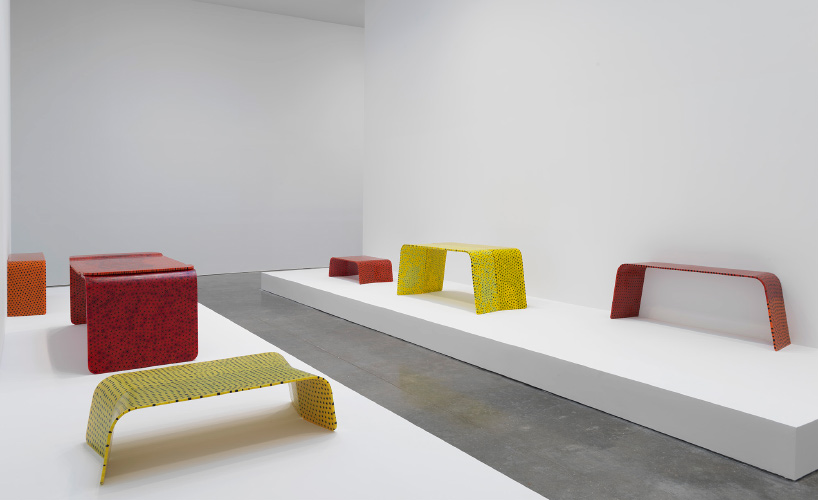
marc newson | installation view, 2018
artwork © marc newson | photo by rob mckeever, courtesy gagosian
MN (continued): the purpose of the collaboration was to reinvigorate and help the people that were badly affected by the tsunami. these industries were frankly suffering anyway, because no one really buys these things anymore. the only people that buy aikuchi (traditionally made japanese swords) are buddhist monasteries, because sword makers in japan are considered somewhere between a normal person and a sort of deity. so that was a mad, fantastic, once in a lifetime experience.
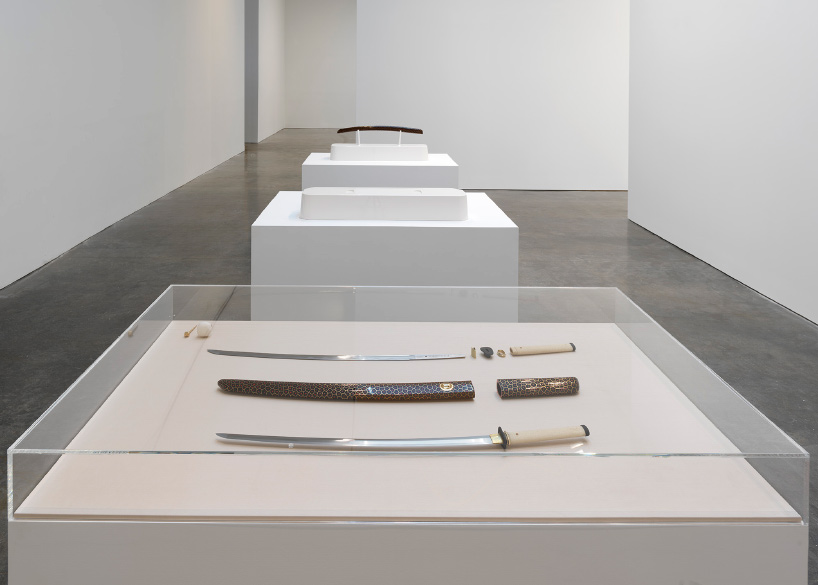
marc newson | installation view, 2018
artwork © marc newson | photo by rob mckeever, courtesy gagosian
(main image) marc newson | installation view, 2018
artwork © marc newson | photo by rob mckeever courtesy gagosian
gagosian (26)
marc newson (48)
PRODUCT LIBRARY
a diverse digital database that acts as a valuable guide in gaining insight and information about a product directly from the manufacturer, and serves as a rich reference point in developing a project or scheme.
